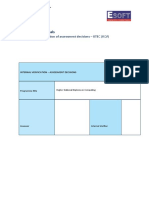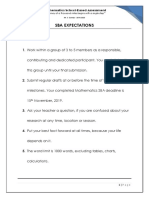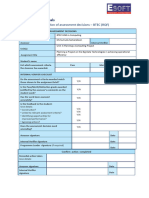0 ratings0% found this document useful (0 votes)
318 viewsEdpm Study Guide
Intellectual property refers to creations of the mind that are protected by law. Intellectual property laws protect economic rights like payments for use and moral rights like preventing misrepresentation of works. Ethical standards require properly citing sources to avoid plagiarism, which is using someone's intellectual property without credit. Guidelines for avoiding plagiarism include acknowledging references, obtaining permission to use others' works, citing sources, paraphrasing properly, and giving credit where it is due.
Uploaded by
TishaunaCopyright
© © All Rights Reserved
Available Formats
Download as DOCX, PDF, TXT or read online on Scribd
0 ratings0% found this document useful (0 votes)
318 viewsEdpm Study Guide
Intellectual property refers to creations of the mind that are protected by law. Intellectual property laws protect economic rights like payments for use and moral rights like preventing misrepresentation of works. Ethical standards require properly citing sources to avoid plagiarism, which is using someone's intellectual property without credit. Guidelines for avoiding plagiarism include acknowledging references, obtaining permission to use others' works, citing sources, paraphrasing properly, and giving credit where it is due.
Uploaded by
TishaunaCopyright
© © All Rights Reserved
Available Formats
Download as DOCX, PDF, TXT or read online on Scribd
You are on page 1/ 4
Grade 11
Study Guide - Section IX (Ethics)
Electronic Document and Preparation Management
Students should be able to:
1. Explain the concept of intellectual property.
2. Describe the rights that are protected by intellectual
property laws.
3. Discuss ethical standards with respect to intellectual
property.
4. Explain the concept of plagiarism.
5. List guidelines to avoid plagiarism.
Explain the concept of intellectual property.
Intellectual property rights are the rights given to
persons over the creations of their minds. They
usually give the creator an exclusive right over
the use of his/her creation for a certain period of
time.
Intellectual property- protection of the rights of
persons who produce, gather or disseminate
ideas and information, including authors, singers
and journalists.
Describe the rights that are protected by intellectual
property laws.
Economic rights- the level of payments for use of the
product by third parties.
Moral rights- violating the integrity and reputation of
the author through misrepresentation or misquoting of
the work.
Discuss ethical standards with respect to intellectual
property.
The copyright concept- Copyright is a legal protection that
allows a person who creates original work of art, music,
literature,etc to completely control how others may use
his work.
Stakeholders / persons involved in intellectual
property.
Publishers or distributors- are those who enter into
agreements with producers to record, film or print the
material and distribute it in ways that would secure
the financial interests of producers and prevent the
unethical use of the material.
Consumers or users- are those who have access to all
types of information but must acknowledge the source
or seek permission of the producer through the
publisher, who may charge a fee under certain
circumstances.
Producers or Owners- are those who maintain
ownership and control over their material and receive
financial reward from the user, through the publisher.
Explain the concept of plagiarism.
Plagiarism- the use of someone’s intellectual property
without giving appropriate credit.
List guidelines to avoid plagiarism.
1. Acknowledgement of references in text and
bibliography, for example, use of referencing.
2. Formats
3. Obtaining approval to use other persons’ work.
4. Site reference sources by acknowledging the author
5. Paraphrase
6. Acknowledge the author
7. Place author’s work in quotations
8. Make sure you give credit to where it is due
9. Use the information to generate your own ideas.
Acceptable work standards
Organization of work and work station
Submission of assignments
Execution of effective time management
Follow- up procedures
Elements of desirable habits and work attitudes
a) Individual responsibility or working without
supervision
b) Willingness
c) Meeting deadlines
d) Team spirit
e) Meeting deadlines
f) Team spirt
g) Co- operation
h) Recognition of diversity
i) Courtesy
j) Punctuality and regularity
k) Good grooming
l) Personal Integrity
m) Respect for other
You might also like
- Hourglass Workout Program by Luisagiuliet 276% (21)Hourglass Workout Program by Luisagiuliet 251 pages
- The Hold Me Tight Workbook - Dr. Sue Johnson100% (16)The Hold Me Tight Workbook - Dr. Sue Johnson187 pages
- Read People Like A Book by Patrick King-Edited62% (65)Read People Like A Book by Patrick King-Edited12 pages
- Livingood, Blake - Livingood Daily Your 21-Day Guide To Experience Real Health77% (13)Livingood, Blake - Livingood Daily Your 21-Day Guide To Experience Real Health260 pages
- COSMIC CONSCIOUSNESS OF HUMANITY - PROBLEMS OF NEW COSMOGONY (V.P.Kaznacheev,. Л. V. Trofimov.)94% (212)COSMIC CONSCIOUSNESS OF HUMANITY - PROBLEMS OF NEW COSMOGONY (V.P.Kaznacheev,. Л. V. Trofimov.)212 pages
- Donald Trump & Jeffrey Epstein Rape Lawsuit and Affidavits83% (1016)Donald Trump & Jeffrey Epstein Rape Lawsuit and Affidavits13 pages
- The 36 Questions That Lead To Love - The New York Times94% (34)The 36 Questions That Lead To Love - The New York Times3 pages
- The 36 Questions That Lead To Love - The New York Times95% (21)The 36 Questions That Lead To Love - The New York Times3 pages
- Jeffrey Epstein39s Little Black Book Unredacted PDF75% (12)Jeffrey Epstein39s Little Black Book Unredacted PDF95 pages
- The 4 Hour Workweek, Expanded and Updated by Timothy Ferriss - Excerpt23% (954)The 4 Hour Workweek, Expanded and Updated by Timothy Ferriss - Excerpt38 pages
- Section 2 - Internal Organizational Environment (2) POB100% (1)Section 2 - Internal Organizational Environment (2) POB13 pages
- CXC CSEC Electronic Document Preparation Management SBA SAMPLE0% (1)CXC CSEC Electronic Document Preparation Management SBA SAMPLE4 pages
- CSEC Information Technology January 2017 P032No ratings yetCSEC Information Technology January 2017 P03213 pages
- Economics, Principle of Accounts and Principle of Business SBA-1No ratings yetEconomics, Principle of Accounts and Principle of Business SBA-130 pages
- CSEC Manufacturing Account 250105 130922No ratings yetCSEC Manufacturing Account 250105 13092211 pages
- Pob Notes: Reasons For Starting A BusinessNo ratings yetPob Notes: Reasons For Starting A Business10 pages
- Csec CXC Pob Past Papers June 2003 Ppaper 02 PDF100% (1)Csec CXC Pob Past Papers June 2003 Ppaper 02 PDF7 pages
- CSEC Mathematics SBA Guideline - MR Conlloyd GumbsNo ratings yetCSEC Mathematics SBA Guideline - MR Conlloyd Gumbs8 pages
- Business Cognate School Based Assessment Research: The Sba/ Research Report Should Be Structured in This MannerNo ratings yetBusiness Cognate School Based Assessment Research: The Sba/ Research Report Should Be Structured in This Manner5 pages
- Csec - Information Technology - Paper03.jan2015oNo ratings yetCsec - Information Technology - Paper03.jan2015o15 pages
- Mathematics SBA Guide PowerPoint 1301008No ratings yetMathematics SBA Guide PowerPoint 130100818 pages
- CSEC Office Administration January 2009 P2No ratings yetCSEC Office Administration January 2009 P28 pages
- GRADE 10 POB SYLLABUS (2020/2021) Section 1: The Nature of BusinessNo ratings yetGRADE 10 POB SYLLABUS (2020/2021) Section 1: The Nature of Business9 pages
- CAPE Unit 1 Management of Business June 2011 P2No ratings yetCAPE Unit 1 Management of Business June 2011 P25 pages
- Factors To Be Considered Is Selecting Communication MediaNo ratings yetFactors To Be Considered Is Selecting Communication Media2 pages
- SBA 2020 GROUP 1 (Completed and Revised)No ratings yetSBA 2020 GROUP 1 (Completed and Revised)27 pages
- Jamaica Driver's Education Handbook: A Comprehensive Driver Training GuideFrom EverandJamaica Driver's Education Handbook: A Comprehensive Driver Training GuideNo ratings yet
- Preying on the Blessings of Praying: Soaring to New Heights on Wings of PrayerFrom EverandPreying on the Blessings of Praying: Soaring to New Heights on Wings of Prayer5/5 (1)
- Beige and Brown Aesthetic Group Project Presentation - 20240306 - 193715 - 0000No ratings yetBeige and Brown Aesthetic Group Project Presentation - 20240306 - 193715 - 000017 pages
- Electronic Document Preparation PowerpointNo ratings yetElectronic Document Preparation Powerpoint8 pages
- Publishing Misconduct: A Need of Understanding and ReductionNo ratings yetPublishing Misconduct: A Need of Understanding and Reduction7 pages
- J. HLAA130-1-Jul-Dec2024-SA2-AA-V3-19072024No ratings yetJ. HLAA130-1-Jul-Dec2024-SA2-AA-V3-1907202410 pages
- CAM - ADR Magazine Writing Competition 2025No ratings yetCAM - ADR Magazine Writing Competition 20258 pages
- Palm Beach State College Course Syllabus: Page: 1 of 4No ratings yetPalm Beach State College Course Syllabus: Page: 1 of 44 pages
- IFPSP 2024 Student Contest Rules and Regulations EN 20230923No ratings yetIFPSP 2024 Student Contest Rules and Regulations EN 202309238 pages
- Undergraduate Assessment and Style Guide 2024-25 (PolIR) FinalNo ratings yetUndergraduate Assessment and Style Guide 2024-25 (PolIR) Final34 pages
- UT Dallas Syllabus For hmgt6320.501.09f Taught by (fwf081000)No ratings yetUT Dallas Syllabus For hmgt6320.501.09f Taught by (fwf081000)7 pages
- 5214-1693458878915-Unit 6 2023 To 2024 Academic Year AssignmentNo ratings yet5214-1693458878915-Unit 6 2023 To 2024 Academic Year Assignment16 pages
- Livingood, Blake - Livingood Daily Your 21-Day Guide To Experience Real HealthLivingood, Blake - Livingood Daily Your 21-Day Guide To Experience Real Health
- COSMIC CONSCIOUSNESS OF HUMANITY - PROBLEMS OF NEW COSMOGONY (V.P.Kaznacheev,. Л. V. Trofimov.)COSMIC CONSCIOUSNESS OF HUMANITY - PROBLEMS OF NEW COSMOGONY (V.P.Kaznacheev,. Л. V. Trofimov.)
- Donald Trump & Jeffrey Epstein Rape Lawsuit and AffidavitsDonald Trump & Jeffrey Epstein Rape Lawsuit and Affidavits
- The 36 Questions That Lead To Love - The New York TimesThe 36 Questions That Lead To Love - The New York Times
- The 36 Questions That Lead To Love - The New York TimesThe 36 Questions That Lead To Love - The New York Times
- Jeffrey Epstein39s Little Black Book Unredacted PDFJeffrey Epstein39s Little Black Book Unredacted PDF
- The 4 Hour Workweek, Expanded and Updated by Timothy Ferriss - ExcerptThe 4 Hour Workweek, Expanded and Updated by Timothy Ferriss - Excerpt
- Section 2 - Internal Organizational Environment (2) POBSection 2 - Internal Organizational Environment (2) POB
- CXC CSEC Electronic Document Preparation Management SBA SAMPLECXC CSEC Electronic Document Preparation Management SBA SAMPLE
- Economics, Principle of Accounts and Principle of Business SBA-1Economics, Principle of Accounts and Principle of Business SBA-1
- CSEC Mathematics SBA Guideline - MR Conlloyd GumbsCSEC Mathematics SBA Guideline - MR Conlloyd Gumbs
- Business Cognate School Based Assessment Research: The Sba/ Research Report Should Be Structured in This MannerBusiness Cognate School Based Assessment Research: The Sba/ Research Report Should Be Structured in This Manner
- GRADE 10 POB SYLLABUS (2020/2021) Section 1: The Nature of BusinessGRADE 10 POB SYLLABUS (2020/2021) Section 1: The Nature of Business
- Factors To Be Considered Is Selecting Communication MediaFactors To Be Considered Is Selecting Communication Media
- Jamaica Driver's Education Handbook: A Comprehensive Driver Training GuideFrom EverandJamaica Driver's Education Handbook: A Comprehensive Driver Training Guide
- Preying on the Blessings of Praying: Soaring to New Heights on Wings of PrayerFrom EverandPreying on the Blessings of Praying: Soaring to New Heights on Wings of Prayer
- Beige and Brown Aesthetic Group Project Presentation - 20240306 - 193715 - 0000Beige and Brown Aesthetic Group Project Presentation - 20240306 - 193715 - 0000
- Publishing Misconduct: A Need of Understanding and ReductionPublishing Misconduct: A Need of Understanding and Reduction
- Palm Beach State College Course Syllabus: Page: 1 of 4Palm Beach State College Course Syllabus: Page: 1 of 4
- IFPSP 2024 Student Contest Rules and Regulations EN 20230923IFPSP 2024 Student Contest Rules and Regulations EN 20230923
- Undergraduate Assessment and Style Guide 2024-25 (PolIR) FinalUndergraduate Assessment and Style Guide 2024-25 (PolIR) Final
- UT Dallas Syllabus For hmgt6320.501.09f Taught by (fwf081000)UT Dallas Syllabus For hmgt6320.501.09f Taught by (fwf081000)
- 5214-1693458878915-Unit 6 2023 To 2024 Academic Year Assignment5214-1693458878915-Unit 6 2023 To 2024 Academic Year Assignment























































































































